(完整)初一英语时态
- 格式:doc
- 大小:35.51 KB
- 文档页数:3
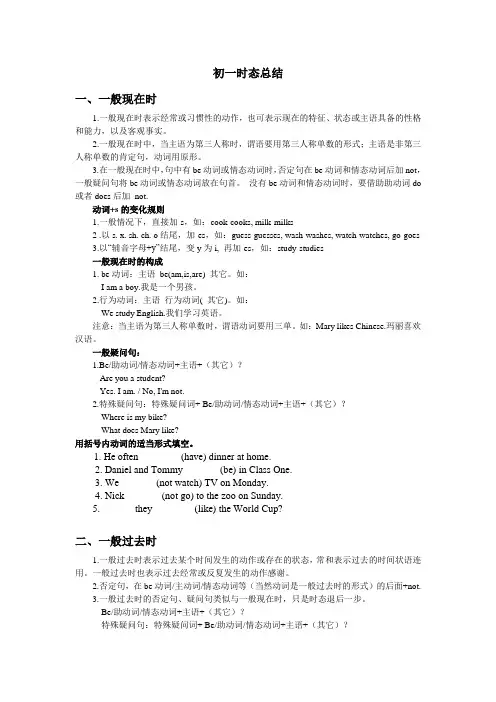
初一时态总结一、一般现在时1.一般现在时表示经常或习惯性的动作,也可表示现在的特征、状态或主语具备的性格和能力,以及客观事实。
2.一般现在时中,当主语为第三人称时,谓语要用第三人称单数的形式;主语是非第三人称单数的肯定句,动词用原形。
3.在一般现在时中,句中有be动词或情态动词时,否定句在be动词和情态动词后加not,一般疑问句将be动词或情态动词放在句首。
没有be动词和情态动词时,要借助助动词do 或者does后加not.动词+s的变化规则1.一般情况下,直接加-s,如:cook-cooks, milk-milks2 .以s. x. sh. ch. o结尾,加-es,如:guess-guesses, wash-washes, watch-watches, go-goes3.以“辅音字母+y”结尾,变y为i, 再加-es,如:study-studies一般现在时的构成1. be动词:主语be(am,is,are) 其它。
如:I am a boy.我是一个男孩。
2.行为动词:主语行为动词( 其它)。
如:We study English.我们学习英语。
注意:当主语为第三人称单数时,谓语动词要用三单。
如:Mary likes Chinese.玛丽喜欢汉语。
一般疑问句:1.Be/助动词/情态动词+主语+(其它)?-Are you a student?-Yes. I am. / No, I'm not.2.特殊疑问句:特殊疑问词+ Be/助动词/情态动词+主语+(其它)?Where is my bike?What does Mary like?用括号内动词的适当形式填空。
1. He often ________(have) dinner at home.2. Daniel and Tommy _______(be) in Class One.3. We _______(not watch) TV on Monday.4. Nick _______(not go) to the zoo on Sunday.5. ______ they ________(like) the World Cup?二、一般过去时1.一般过去时表示过去某个时间发生的动作或存在的状态,常和表示过去的时间状语连用。
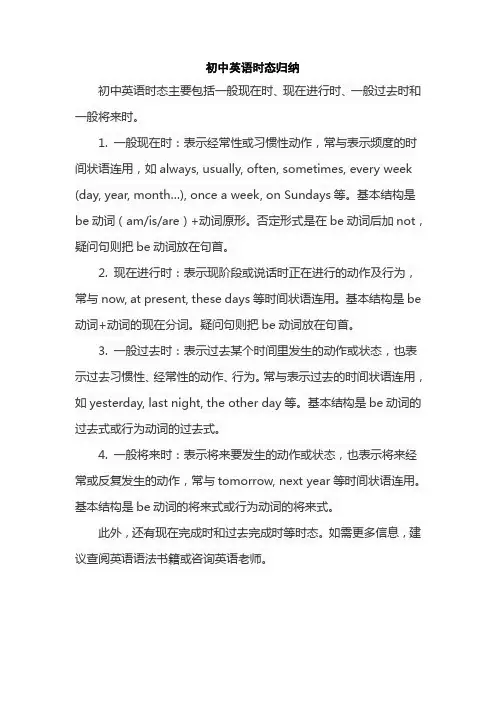
初中英语时态归纳
初中英语时态主要包括一般现在时、现在进行时、一般过去时和一般将来时。
1. 一般现在时:表示经常性或习惯性动作,常与表示频度的时间状语连用,如always, usually, often, sometimes, every week (day, year, month…), once a week, on Sundays等。
基本结构是be动词(am/is/are)+动词原形。
否定形式是在be动词后加not,疑问句则把be动词放在句首。
2. 现在进行时:表示现阶段或说话时正在进行的动作及行为,常与now, at present, these days等时间状语连用。
基本结构是be 动词+动词的现在分词。
疑问句则把be动词放在句首。
3. 一般过去时:表示过去某个时间里发生的动作或状态,也表示过去习惯性、经常性的动作、行为。
常与表示过去的时间状语连用,如yesterday, last night, the other day等。
基本结构是be动词的过去式或行为动词的过去式。
4. 一般将来时:表示将来要发生的动作或状态,也表示将来经常或反复发生的动作,常与tomorrow, next year等时间状语连用。
基本结构是be动词的将来式或行为动词的将来式。
此外,还有现在完成时和过去完成时等时态。
如需更多信息,建议查阅英语语法书籍或咨询英语老师。
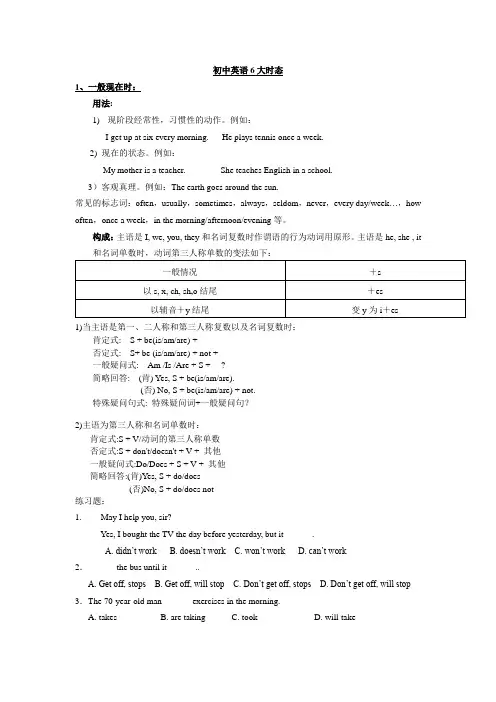
初中英语6大时态1、一般现在时:用法:1)现阶段经常性,习惯性的动作。
例如:I get up at six every morning. He plays tennis once a week.2) 现在的状态。
例如:My mother is a teacher. She teaches English in a school.3)客观真理。
例如:The earth goes around the sun.常见的标志词:often,usually,sometimes,always,seldom,never,every day/week…,how often,once a week,in the morning/afternoon/evening等。
构成:主语是I, we, you, they和名词复数时作谓语的行为动词用原形。
主语是he, she , it1)当主语是第一、二人称和第三人称复数以及名词复数时:肯定式: S + be(is/am/are) + ···否定式: S+ be (is/am/are) + not + ···一般疑问式: Am /Is /Are + S + ···?简略回答: (肯) Yes, S + be(is/am/are).(否) No, S + be(is/am/are) + not.特殊疑问句式: 特殊疑问词+一般疑问句?2)主语为第三人称和名词单数时:肯定式:S + V/动词的第三人称单数否定式:S + don't/doesn't + V + 其他一般疑问式:Do/Does + S + V + 其他简略回答:(肯)Yes, S + do/does(否)No, S + do/does not练习题:1.--- May I help you, sir?--- Yes, I bought the TV the day before yesterday, but it ______.A. didn’t workB. doesn’t workC. won’t workD. can’t work2.______ the bus until it ______..A. Get off, stopsB. Get off, will stopC. Don’t get off, stopsD. Don’t get off, will stop 3.The 70-year-old man ______ exercises in the morning.A. takesB. are takingC. tookD. will take用法:1).将要发生的动作。

初一英语时态总结一、一般现在时态(Simple Present Tense)1. 表示经常性或习惯性的动作、状态或真理。
例句:I often go to school by bus.(我经常坐公交车去学校。
) Water boils at 100 degrees Celsius.(水在100摄氏度时沸腾。
)2. 表示客观事实、科学真理或普遍规律。
例句:The sun rises in the east.(太阳从东方升起。
)Water freezes at 0 degrees Celsius.(水在0摄氏度时结冰。
) 3. 表示主语的特性或个人喜好。
例句:She likes playing basketball.(她喜欢打篮球。
)He is a smart boy.(他是个聪明的男孩。
)二、一般过去时态(Simple Past Tense)1. 表示过去某个时间发生的动作或状态。
例句:I went to the park yesterday.(我昨天去了公园。
) They lived in China when they were young.(他们年轻时住在中国。
)2. 表示过去的习惯或经常性动作。
例句:We used to play soccer every weekend.(我们过去每个周末都踢足球。
)She always studied until late at night.(她过去总是学习到很晚。
)3. 表示过去的真理或规律。
例句:Dinosaurs existed millions of years ago.(恐龙存在于几百万年前。
)The Earth was flat according to ancient beliefs.(根据古代的信仰,地球是平的。
)三、一般将来时态(Simple Future Tense)1. 表示将来某个时间或在某个时间之后发生的动作或状态。
例句:I will visit my grandparents next week.(下周我会去看望我的祖父母。

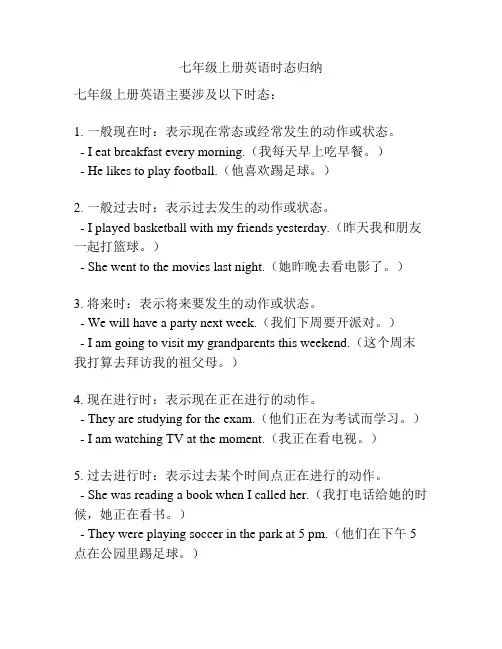
七年级上册英语时态归纳七年级上册英语主要涉及以下时态:1. 一般现在时:表示现在常态或经常发生的动作或状态。
- I eat breakfast every morning.(我每天早上吃早餐。
)- He likes to play football.(他喜欢踢足球。
)2. 一般过去时:表示过去发生的动作或状态。
- I played basketball with my friends yesterday.(昨天我和朋友一起打篮球。
)- She went to the movies last night.(她昨晚去看电影了。
)3. 将来时:表示将来要发生的动作或状态。
- We will have a party next week.(我们下周要开派对。
)- I am going to visit my grandparents this weekend.(这个周末我打算去拜访我的祖父母。
)4. 现在进行时:表示现在正在进行的动作。
- They are studying for the exam.(他们正在为考试而学习。
) - I am watching TV at the moment.(我正在看电视。
)5. 过去进行时:表示过去某个时间点正在进行的动作。
- She was reading a book when I called her.(我打电话给她的时候,她正在看书。
)- They were playing soccer in the park at 5 pm.(他们在下午5点在公园里踢足球。
)6. 现在完成时:表示过去发生的动作与现在产生的影响或结果。
- I have finished my homework.(我已经完成了我的作业。
)- She has lived in this city for ten years.(她在这个城市已经住了十年了。
)这些是七年级上册英语的主要时态,通过学习这些时态,你将能够更好地理解和运用英语语法。
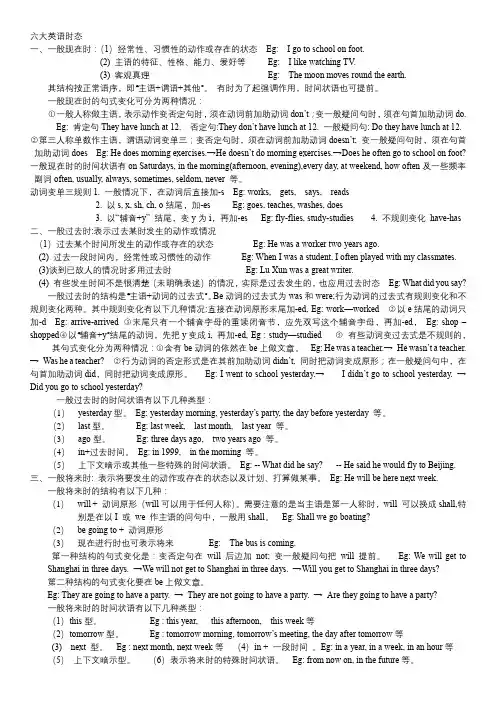
六大英语时态一、一般现在时:(1)经常性、习惯性的动作或存在的状态Eg: I go to school on foot.(2) 主语的特征、性格、能力、爱好等Eg: I like watching TV.(3) 客观真理Eg: The moon moves round the earth.其结构按正常语序,即“主语+谓语+其他”。
有时为了起强调作用,时间状语也可提前。
一般现在时的句式变化可分为两种情况:○1一般人称做主语,表示动作变否定句时,须在动词前加助动词don’t;变一般疑问句时,须在句首加助动词do.Eg: 肯定句They have lunch at 12. 否定句:They don’t have lunch at 12. 一般疑问句: Do they have lunch at 12.○2第三人称单数作主语,谓语动词变单三;变否定句时,须在动词前加助动词doesn’t; 变一般疑问句时,须在句首加助动词does Eg: He does morning exercises.→He doesn’t do morning exercises.→Does he often go to school on foot?一般现在时的时间状语有on Saturdays, in the morning(afternoon, evening),every day, at weekend, how often及一些频率副词often, usually, always, sometimes, seldom, never 等。
动词变单三规则1. 一般情况下,在动词后直接加-s Eg: works, gets, says, reads2. 以s, x, sh, ch, o结尾,加-es Eg: goes, teaches, washes, does3. 以“辅音+y” 结尾,变y为i,再加-es Eg: fly-flies, study-studies4. 不规则变化have-has二、一般过去时:表示过去某时发生的动作或情况(1)过去某个时间所发生的动作或存在的状态Eg: He was a worker two years ago.(2) 过去一段时间内,经常性或习惯性的动作Eg: When I was a student, I often played with my classmates.(3)谈到已故人的情况时多用过去时Eg: Lu Xun was a great writer.(4) 有些发生时间不是很清楚(未明确表述)的情况,实际是过去发生的,也应用过去时态Eg: What did you say?一般过去时的结构是“主语+动词的过去式”。
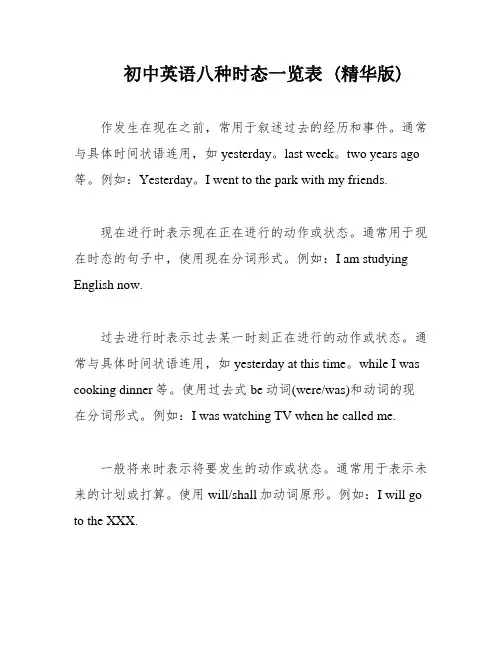
初中英语八种时态一览表 (精华版)作发生在现在之前,常用于叙述过去的经历和事件。
通常与具体时间状语连用,如yesterday。
last week。
two years ago 等。
例如:Yesterday。
I went to the park with my friends.现在进行时表示现在正在进行的动作或状态。
通常用于现在时态的句子中,使用现在分词形式。
例如:I am studying English now.过去进行时表示过去某一时刻正在进行的动作或状态。
通常与具体时间状语连用,如yesterday at this time。
while I was cooking dinner等。
使用过去式be动词(were/was)和动词的现在分词形式。
例如:I was watching TV when he called me.一般将来时表示将要发生的动作或状态。
通常用于表示未来的计划或打算。
使用will/shall加动词原形。
例如:I will go to the XXX.过去将来时表示过去某个时间点将要发生的动作或状态。
通常与具体时间状语连用,使用过去式be动词(were/was)和动词的原形。
例如:Yesterday at this time。
I was going to theparty with my friends.现在完成时表示过去发生的动作对现在的影响或过去延续到现在的动作或状态。
使用have/has加动词的过去分词形式。
例如:I have finished my homework。
so I can relax now.过去完成时表示过去某个时间点之前已经完成的动作或状态。
通常与具体时间状语连用,使用had加动词的过去分词形式。
例如:By the time I arrived。
he had already left.需要使用连词that来引导。
When writing an article。
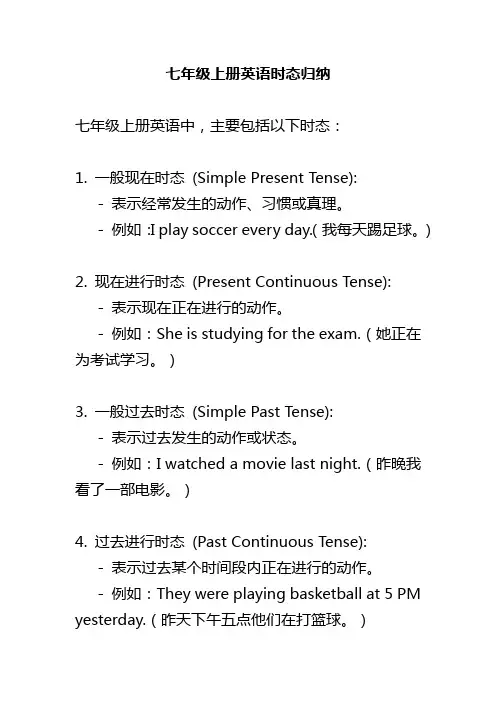
七年级上册英语时态归纳
七年级上册英语中,主要包括以下时态:
1. 一般现在时态(Simple Present Tense):
- 表示经常发生的动作、习惯或真理。
- 例如:I play soccer every day.(我每天踢足球。
)
2. 现在进行时态(Present Continuous Tense):
- 表示现在正在进行的动作。
- 例如:She is studying for the exam.(她正在为考试学习。
)
3. 一般过去时态(Simple Past Tense):
- 表示过去发生的动作或状态。
- 例如:I watched a movie last night.(昨晚我看了一部电影。
)
4. 过去进行时态(Past Continuous Tense):
- 表示过去某个时间段内正在进行的动作。
- 例如:They were playing basketball at 5 PM yesterday.(昨天下午五点他们在打篮球。
)
5. 一般将来时态(Simple Future Tense):
- 表示将来发生的动作或状态。
- 例如:We will go to the beach tomorrow.(明天我们将去海滩。
)
6. 将来进行时态(Future Continuous Tense):
- 表示将来某个时间段内正在进行的动作。
- 例如:He will be studying all night.(他将整晚都在学习。
)。
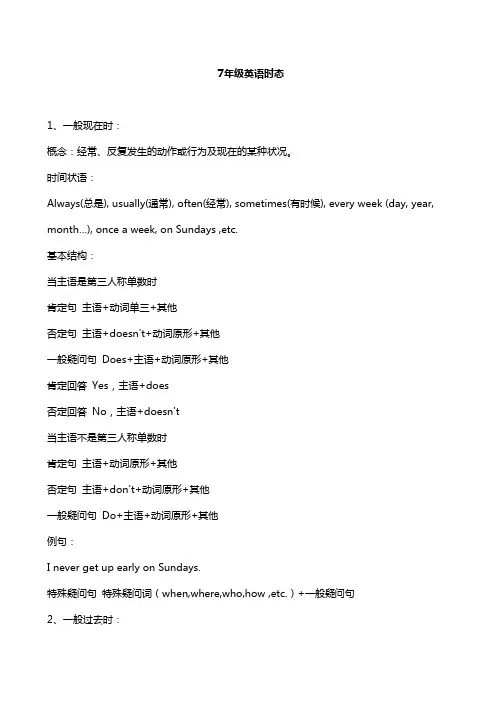
7年级英语时态1、一般现在时:概念:经常、反复发生的动作或行为及现在的某种状况。
时间状语:Always(总是), usually(通常), often(经常), sometimes(有时候), every week (day, year, month…), once a week, on Sundays ,etc.基本结构:当主语是第三人称单数时肯定句主语+动词单三+其他否定句主语+doesn't+动词原形+其他一般疑问句Does+主语+动词原形+其他肯定回答Yes,主语+does否定回答No,主语+doesn't当主语不是第三人称单数时肯定句主语+动词原形+其他否定句主语+don't+动词原形+其他一般疑问句Do+主语+动词原形+其他例句:I never get up early on Sundays.特殊疑问句特殊疑问词(when,where,who,how ,etc.)+一般疑问句2、一般过去时:概念:过去某个时间里发生的动作或状态;过去习惯性、经常性的动作、行为。
时间状语:ago, yesterday, the day before yesterday, last week(year, night, month…), in 1989, just now, at the age of 5, one day, long long ago, once upon a time, etc.基本结构:主语+动词过去式+其他否定形式did+not+do+其他;一般疑问句did+主语+do+其他?例句:I went to Italy .I visited museums and sat in public gardens3、现在进行时:概念:表示现阶段或说话时正在进行的动作及行为。
时间状语:now, at this time(在这一刻), these days, etc.基本结构:am/is/are+doing否定形式:am/is/are+not+doing.一般疑问句:把be动词放于句首。
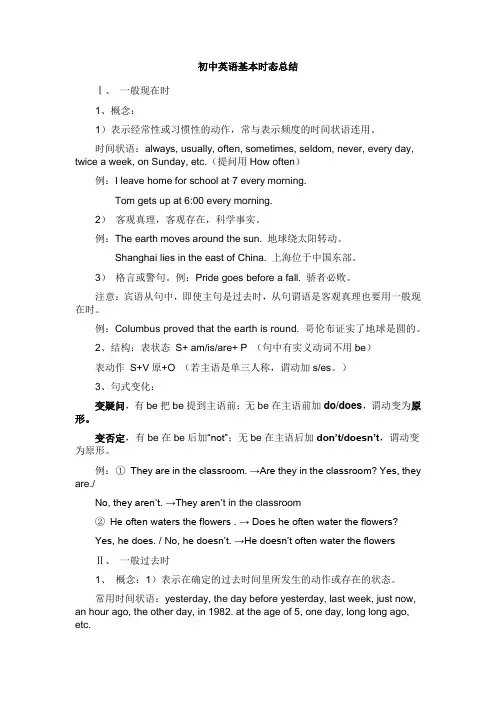
初中英语基本时态总结Ⅰ、一般现在时1、概念:1)表示经常性或习惯性的动作,常与表示频度的时间状语连用。
时间状语:always, usually, often, sometimes, seldom, never, every day, twice a week, on Sunday, etc.(提问用How often)例:I leave home for school at 7 every morning.Tom gets up at 6:00 every morning.2)客观真理,客观存在,科学事实。
例:The earth moves around the sun. 地球绕太阳转动。
Shanghai lies in the east of China. 上海位于中国东部。
3)格言或警句。
例:Pride goes before a fall. 骄者必败。
注意:宾语从句中,即使主句是过去时,从句谓语是客观真理也要用一般现在时。
例:Columbus proved that the earth is round. 哥伦布证实了地球是圆的。
2、结构:表状态S+ am/is/are+ P (句中有实义动词不用be)表动作S+V原+O (若主语是单三人称,谓动加s/es。
)3、句式变化:变疑问,有be把be提到主语前;无be在主语前加do/does,谓动变为原形。
变否定,有be在be后加“not”;无be在主语后加don’t/doesn’t,谓动变为原形。
例:①They are in the classroom. →Are they in the classroom? Yes, they are./No, they aren’t. →They aren’t in the classroom②He often waters the flowers . → Does he often water the flowers?Yes, he does. / No, he doesn’t. →He doesn’t often water the flowersⅡ、一般过去时1、概念:1)表示在确定的过去时间里所发生的动作或存在的状态。
初中英语所有时态1.一般现在时(do/does; is/am/are)①表示现在的情况、状态或特征。
例:He is a student.他是一个学生。
②表示经常性、习惯性动作。
例:He always helps others.他总是帮助别人。
③客观事实和普遍真理。
例:The earth moves the sun.地球绕着太阳转。
④表示一个按规定、计划或安排要发生的动作。
仅限于某些表示“来、去、动、停、开始、结束、继续”等的动词,可以与表示未来时间的状语搭配使用。
常见的用法是:飞机、火车、轮船、汽车等定期定点运行的交通方式。
例:The next train leaves at 3 o'clock this afternoon.下一趟火车今天下午3点开车。
⑤在时间、条件和让步状语从句中经常用一般现在(有时也用现在完成时)表示将的来事情。
(即:主将从现原则)例:I will call you as soon as I arrive at the airport.我一到机场就会给你打电话。
When you have finished the report, I will have waited for about 3 hours.等你完成这份报告的时候,我就已经等了将近3个小时了。
2. 现在进行时(am/is/are doing)①表示此时此刻正在发生的事情。
例:He is listning to the music now.他现在正在听音乐。
②表示目前一段时间内一直在做的事情,但不一定此时此刻正在做。
例:I am studying computer this term.这个学期我一直在学习计算机。
③现在进行时可以表示将来的含义。
瞬时动词的进行一定表将来。
例:I am leaving.我要离开了。
持续动词的进行只有有将来的时间状语或有将来语境中才表将来。
例:I am travelling next month.下个月我要去旅行。
名称一般现在时现在进行时一般过去时用法(1)一般现在时通常表示目前阶段经常发生的动作(行为动词)或存在的状态。
(含be动词);(2)表示事实,现状,性质或经常的习惯的动作现在进行时表示目前或目前阶段正在进行的动作。
一般过去时表示过去发生的动作(行为动词过去式)或存在的状态(含be动词过去式)谓语构成1、含be动词:肯定式:主语+ am /is/are +其他否定式:主语+ am/is/are +not+ 其他疑问式:Am /Is /Are + 主语+ 其他?简略回答: (肯) Yes,主语+ am/ is /are(否) No,主语+ am /is/are not2、行为动词(不含be动词)肯定式:(1)三单主语+动词的第三人称单数+其他.(2)非三单主语+动词原形+其他.否定式(1)三单主语+助动词does n't +动词原形+其他.(2)非三单主语+助动词do n't +动词原形+其他.疑问式:(1)Does+三单主语+动词原形+其他?简略回答:(肯)Yes,主语+does(否)No,主语+does not(2)Do+非三单主语+动词原形+其他?简略回答:(肯)Yes,主语+do(否)No,主语+do not肯定式:(1)三单主语+is+动词ing+其他.(2)非三单主语+be+动词ing+其他.否定式(1)三单主语+is not+动词ing+其他.(2)非三单主语+benot+动词ing+其他.疑问式:(1)Is+三单主语+动词ing+其他?简略回答:(肯)Yes,主语+is(否)No,主语+is not(2)Be+非三单主语+动词ing+其他?简略回答:(肯)Yes,主语+be(否)No,主语+be not1、含be动词肯定式:主语+was/were + 其他否定式:主语+ was/were not +其他疑问式:Was/Were + 主语+ 其他?简略回答(肯)Yes, 主语+was/were.(否)No , 主语+ wasnot/were not.2、行为动词(不含be动词)肯定式:主语+动词的过去式+其他否定式:主语+ did not + 动词原形+ 其他疑问式:Did + 主语+ 动词原形+ 其他简略回答.(肯)Yes, 主语+did(否)No , 主语+ didn't.识记(1)be动词的用法(2)动词原形变第三人称单数动词ing变化动词过去式的变化标志词often, usually, always, sometimes,today,every day,once a week, everyfive minutes, on Sundays,in themorning/afternoon/evening等now,right now, at themoment ,these days等,并常出现在祈使句的句子中,与look,listen连用.… ago,just now(刚才),yesterday, last week, inthe old days, when Iwas five years old, in1995(过去的时间) 等名称一般将来时过去进行时现在完成时用法一般将来时通常表示表示计划、打算或将要发生的动作或存在的状态。
七大时态的概念1.一般现在时一般现在时表示经常性、习惯性的动作或状态,常与always,often,sometimes等连用。
其基本句式为:主语+动词原形+其他。
错误示例:He always eat breakfast at seven.(错)正确示例:He always eats breakfast at seven.(对)2.现在进行时现在进行时表示此时此刻正在进行的动作或状态,其基本句式为:主语+be动词+动词现在分词+其他。
错误示例:They are having a meeting tomorrow.(错)正确示例:They are having a meeting now.(对)3.现在完成时现在完成时表示过去发生的动作或状态对现在产生的影响或结果,其基本句式为:主语+have/has+动词过去分词+其他。
错误示例:I have buy a book.(错)正确示例:I have bought a book.(对)4.一般过去时一般过去时表示过去某个时间点或过去经常发生的动作或状态,常与last week,yesterday等连用。
其基本句式为:主语+动词过去式+其他。
错误示例:They went to the park yesterday.(错)正确示例:They went to the park last week.(对)5.过去进行时过去进行时表示过去某个时间点正在进行的动作或状态,其基本句式为:主语+was/were+动词现在分词+其他。
错误示例:She was having a shower at nine o’clock yesterday.(错)正确示例:She was having a shower at nine o’clock yesterday morning.(对)6.过去完成时过去完成时表示过去某个时间点之前已经完成的动作或状态,其基本句式为:主语+had+动词过去分词+其他。
初⼀英语四⼤时态初⼀英语四⼤时态⼀、⼀般现在时1.概念: 经常、反复发⽣的动作及现在的某种状况。
2.时间状语——标志词:always,usually,often,sometimes,every week,on Sundays,etc3.肯定句:主语+be(am,is,are); 主语(其余⼈称)+动词原形; 主语(三单)+动三单(V-s/es),4.否定形式:主语+am(is/are)+not ; 主语+don’t+动原; 主语(三单)+does’t+动原5.⼀般疑问句: Am/ Is /Are+主语………….? Do/Does+主语+动原………..?专项练习⽤括号内动词的适当形式填空。
1.He often (have) dinner at home.2.David and Tom (be) in Class One.3.We (not watch) TV on Mondays.4.Mike (like) cooking.4.You always (do) your homework well. 8.Liu Tao (not like) PE.9.The child often (watch) TV in the morning. 10.Everyone in our class (like) PE a lot.按要求改写句⼦1.David watches TV in the evening.否定句:David TV in the evening.⼀般疑问句:David TV in the evening? Yes,he对划线部分提问:David TV?2.I do my homework every day.否定句:I do my homework every day.⼀般疑问句:you your homework every day? No,I .对划线部分提问:you every day?3.She is a worker.否定句:She a worker.⼀般疑问句:She a worker?对划线部分提问:She?= She ?⼆、⼀般过去时1.概念: 过去某个时间⾥发⽣的动作或状态;过去习惯性、经常性的动作、⾏为。
七年级英语时态语态详解【时态一】一般现在时:常与always,often,sometimes, every day连用,表示习惯或经常反复发生的动作或存在的状态。
提醒你当第三人称单数做主语时,别忘了动词的变化。
注意:象"地球大,月亮小"等客观真理、事实一定用一般现在时。
现在进行时:要注意其构成:由be+动词+ing,表示说话时正在进行的动作。
如:We're studying now. 我们现在正在学习。
一般过去时:表示过去某个时间发生的动作或存在的状态,常与yesterday,last year,in 1949,two years ago,等表示过去时间的状语连用。
注意:We often went to dance last summer.有的同学一见到often就想到用一般现在时,其实因为后面有表示过去时间的last summer,所以要用过去式,千万别误用了,切记,切记。
过去进行时:显然过去进行时表示过去某一时刻正在做什么,常和特定的时间状语如at that time,at six yesterday,at that moment,when he came in等连用。
如:When he knocked at the door,his mother was cooking.一般将来时:表示将要发生的动作或存在的状态,常与表示将来时间状语如next year,tomorrow等连用。
注意:在Will you ....?问句中,回答必须是Yes,I will.或No,I won't而不能用Yes,I shall. No, I shan't.来回答过去将来时:过去将来时不可以单独使用,它一般在宾语从句中作间接引语,表示从过去某一时间看来将要发生的动作或存在的状态。
如:They told me that they would go to work in Guangdong.现在完成时:顾名思义,现在完成时表示的是已经完成的动作,但动作造成的影响还在,常被just,already,yet 等副词修饰。
初中英语时态一览表以下是初中英语主要时态的一览表:1. 现在一般时:I eat an apple every day.2. 过去一般时:She studied English last year.3. 现在进行时:They are playing basketball now.4. 过去进行时:They were having dinner at this time yesterday.5. 现在完成时:I have finished my homework.6. 过去完成时:They had learned 2000 English words by the end of last year.7. 现在完成进行时:We have been waiting for you for half an hour.8. 过去完成进行时:We had been learning English for 3 years by the end of last year.9. 将来一般时:She will visit her grandparents next week.10. 将来进行时:They will be having a meeting tomorrow.11. 将来完成时:They will have finished their work by the end of this week.12. 过去将来一般时:He said he would go to the library the next day.13. 过去将来进行时:He said he would be working on his project over the weekend.14. 过去将来完成时:He said he would have written the report by the end of the month.希望这个一览表能帮到你!如果你还有其他问题,请随时提问。
初一英语时态专题复习
一、一般现在时:(1、现在的状态。
2、经常或习惯性动作。
3、主语所具备的性格和能力。
4、真理。
)
1、标志:often(经常),usually(通常),sometimes(有时),always(总是),never(从不), on Sundays(在星期天), every day/month/year(每一天/月/年)
2、结构:
(1)主语+连系动词be(am/is/are)+名词/形容词/数词/介词短语/副词等做表语表状态(包括There be +n.)
练习:
1.I______(be) a student. My name_____(be) Tom.
2. Where _____(be) my shoes? They___(be) here.
3.Who ____(be) the girl with long straight hair? I think she ___(be) Kate.
4. You and I ___(not be) in Class Six.
5.___(be) there a supermarket on the Fifth Avenue? Yes, there_____(be).
6. ____ her parent tall? No, he____.
(2)主语(非第三人称单数)+行为动词原形+其他(用助动词do 帮助构成否定句、一般疑问句和特殊疑问)
(3)主语(第三人称单数)+行为动词的第三人称单数+其他(用助动词does 帮助构成否定句、一般疑问句和特殊疑问句)
行为动词第三人称单数加-s的形式 1.- s 2. 辅音+y: study-studies 3.以s,x,ch,sh结尾watch-watches teach-teaches4特殊have-has do-does go-goes
练习:
1)His parents _______(watch) TV every night. 肯定句1) My brother _________(do) homework every day.
2)His parents _________(not watch) every night.否定句2)My brother________(not do)homework every day.
3)_____his parents_____(watch) TV every night?一般疑3)______ your brother _____ homework every day?
Yes, they _______. No, they _______. Yes, he______. No, he _________. 4)When___ his parents _____(watch) TV? 特疑4)When _____ your brother ____(do) homework?
They watch TV every night. He does homework every day.
二、现在进行时:表示说话瞬间或现阶段正在进行的动作。
1、标志: now(现在)listen(看)look(听)
2、结构:主语+助动词be(am/is/are)+行为动词的现在分词(doing)
现在分词的构成:1.-ing: eat-eating 2.辅音字母+e: take-taking
3. sit, put, begin, run, swim, stop, get, shop,(双写最后一个辅音字母,再加ing.)
练习:
1. Jim __________________(take) photos in the park now.
2. Jim_________(not take) in the park now.
3. ___________Jim_________(take) photos in the park now? Yes, he _____. No, he _______.
4. Where _________Jim ____________ photos now? In the park.
三、情态动词:1、任何主语+can/may/must+动词原形 2、主语+ can’t/may not/ mustn’t+动词原形
1、Can/May/Must + 主语+ 动词原形?
2、疑问词+can/may/must+主语+动词原形?
四、非谓语动词(是固定搭配)
1. like+ to do不定式/doing动名词
2.want to do sth.
3. love to do
4. would like to do sth.
5. enjoy doing sth.
6. thanks for doing
7. stop doing sth
8. let sb. do sth.
练习:
She wants _____(have) a party. Does he like _______(swim)?
Thanks for _______(enjoy) CCTV show. She never stops ____(talk).
五、祈使句:
Go straight and turn left/ right.
Go through Fifth Avenue.
Take a taxi(Take a bus,Take a walk……)
六、There be句型
练习:
句型转换
1)There is a bank on the street. 2) There are some cars in front of the park.
否定句:There _______a bank on the street. 否定句:There ______ _______cars in front of the bank.
一般疑问句:_______ ______ a bank on the street? 一般疑问句:____ ______ ______cars in front of the bank?
就划线部分提问:________ on the street? 就划线部分提问:_____ _____ in front of the bank?
There’s a bank on the street. The re are some cars in front of the bank.
同上:____ ______ ______are there on the street? 同上:____ ____ ____ are there in front of the bank
There’s only one. There’re some.
2)将下列句子改为否定句、一般疑问句,并就划线部分提问。
1. We are eating lunch. We eat lunch at noon.
2.He is swimming at a pool. He swims at the pool every day.
3.Jim and Tony are playing basketball at school. Jim and Tony play basketball on Sundays.
4.Sandra is running. Sandra likes running
七、综合练习:1.Mr Green _____(be) a worker. Now he ____(work) in the field. 2.Listen! Who_______(sing)?
3.What time ____ your brother usually _____(do) his homework?
4.You can_______(come) here by bus.
5. Who ____(have) a ruler?
6.Are they_____(clean) the room?
7.-____ you____(eat) dinner? –Yes, we are.
8.Jack ____(have) a soccer ball, but he ____(not have) a basketball. 9._______Jim _______(like)______(run)?
10.They _____(be) from Canada. They______(not speak) Chinese. 11. He wants _________________(be) tall.
1.我们正在吃晚餐。
2、我们每天6点起床。
We __________________________. We __________________ at six every day.
3.你们在聊天吗?是的。
4、他们常常聊天吗?不是。
_______ they _______? Yes, they _____. ______ they often ______ ? No, they ________.
5、他在做什么?他在做作业。
6、他晚上常干什么?他常做作业。
What ____he ___? He_______. What ___he usually ___ in the evening? He usually______.
答案:1.are having dinner 2. get up 3. Are , talking , are 4. Do , talk, don’t
5. is doing, is doing homework
6. does, do, does , homework。